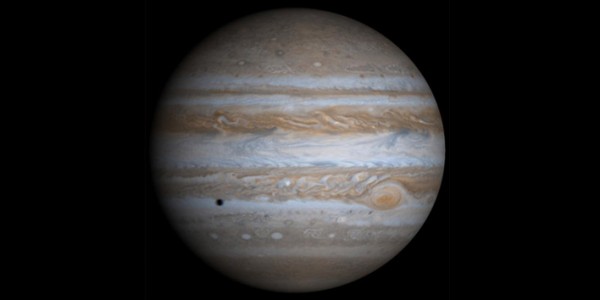Jupiter and the Galilean Satellites
Our largest planet and its moons inspire shock and awe

One morning this past September, I got up, as I do, before 6 to write in my journal for a half hour. Then I decided to check out the stars. The sight was almost shocking. To the east, set in an indigo-black sky, the crescent moon above my neighbor’s cherry tree shone with a silent, luminous brilliance. Above that, Venus blazed. High above Venus and to the south was Jupiter. I could see Jupiter’s many moons with my bare eyes—or so I imagined. To me Jupiter looks like a bright blotch, and what else would those jagged-looking edges be?
Describe Jupiter, and it sounds like hyperbole. Jupiter is huge. It’s a thousand times bigger than Earth and has 300 times more mass. Up there a massive storm has been raging for centuries. This storm could gulp down Earth as if Earth were a nice green grape. The storm is known as the Great Red Spot. Some spot.
It’s no exaggeration to say that Jupiter has 50 moons. These moons are certified by the International Astronomical Union, with 16 more acknowledged as provisional until their orbits can be determined.
Jupiter plus moons make almost a little solar system. (If Jupiter were about 20 times bigger, it would ignite and become a sun.) The planet is a fast-spinning gas giant composed mostly of hydrogen (about 86 percent) and helium (about 14 percent). In its gases, it’s similar to the sun. It has no solid surface but likely has a rock and ice core larger than Earth. Hyper-compressed hydrogen—metallic hydrogen—surrounds the core and generates a strong magnetic field. Next out is molecular hydrogen—hydrogen in the form of two-atom molecules. Then you have the gases, mostly hydrogen and helium, along with ammonia, methane, sulfur, and water vapor. Furious winds stripe Jupiter’s surface. The stripes are gases blowing in opposite directions.
In 1610 Galileo was the first to discover Jupiter’s moons. The four he observed from Earth are known as the Galilean satellites.
Io, larger than our moon, is the most violently volcanic body in the solar system. Its surface is sulfurous—red, yellow, and brown with white patches of frozen sulfur dioxide. Io’s surface is solid, but Jupiter’s immense gravity makes solid rock tidal, pulled to heights of 300 feet. Io’s orbit is elliptical, not round, and extremely eccentric. At times, Jovian gravity pulls a lot; at other times, a lot less. Io’s rocks rub together and move and melt and spew lava.
Europa is a bit smaller than Earth’s moon and, like Earth, has an iron core and a rocky mantle. The surface is all ice, a frozen ocean, the ice multicracked and furrowed. It’s as if there were liquid water or at least slush a mile or two down, cracking and moving the ice above. Below deep ice or within it there may be lakes; within the lakes microbial life is possible.
Ganymede, larger than Mercury, has an iron core, which gives it a magnetic field that exists within Jupiter’s magnetic field. A rock mantle surrounds the core, and the top layer is 500-mile-thick ice, mixed with rock. Ganymede’s atmosphere includes oxygen, but it’s way too thin to breathe. Craters decorate its surface of soft ice. They’re called palimpsests, an art term referring to the practice of overpainting in such a way that underlying work shows through. So with Ganymede’s craters.
Finally we have Callisto, with its barren, rocky, crater-pocked surface. It is an old, old surface, whacked multiple times during the early solar system’s Era of Heavy Bombardment. Callisto is geologically inactive. There’s nothing doing, no erosion, no volcanism. Callisto’s broken rocks and cracks and craters are four billion years old. That’s nearly, if not quite, as old as the solar system itself.
Jupiter was the Roman name for the Greek god Zeus, king of the gods. Zeus was all-powerful and super-passionate. His love interests included Io, Europa, and Callisto. Ganymede was a beautiful Trojan boy brought by a raptor to Mount Olympus to serve as cupbearer to the gods.
The Greeks and Romans were in awe of their Jupiter. I am in awe of ours.

